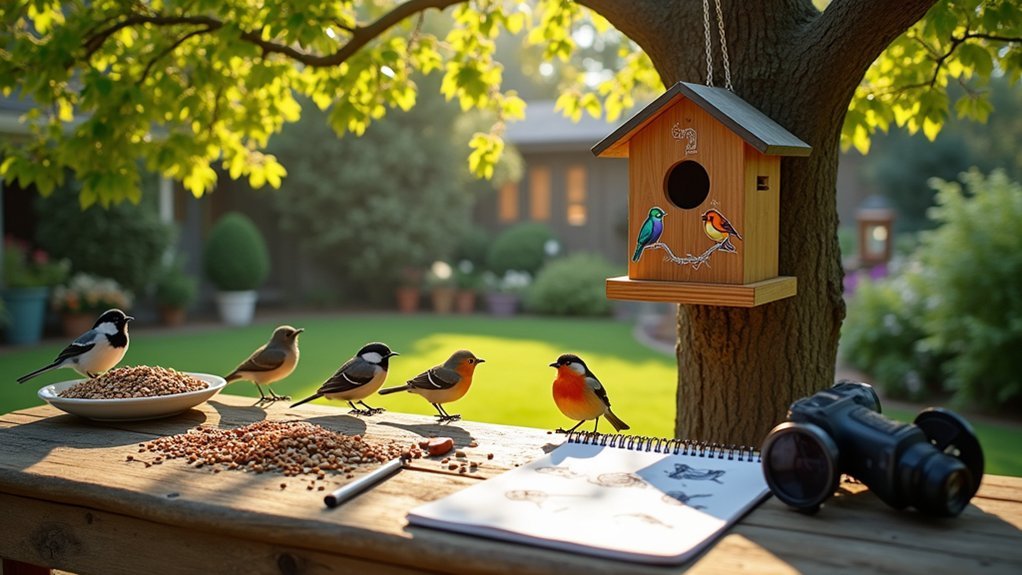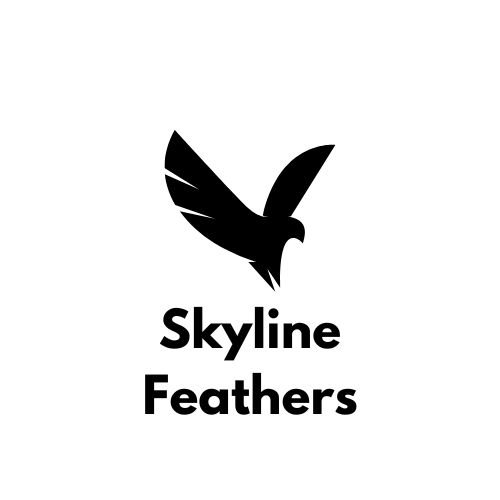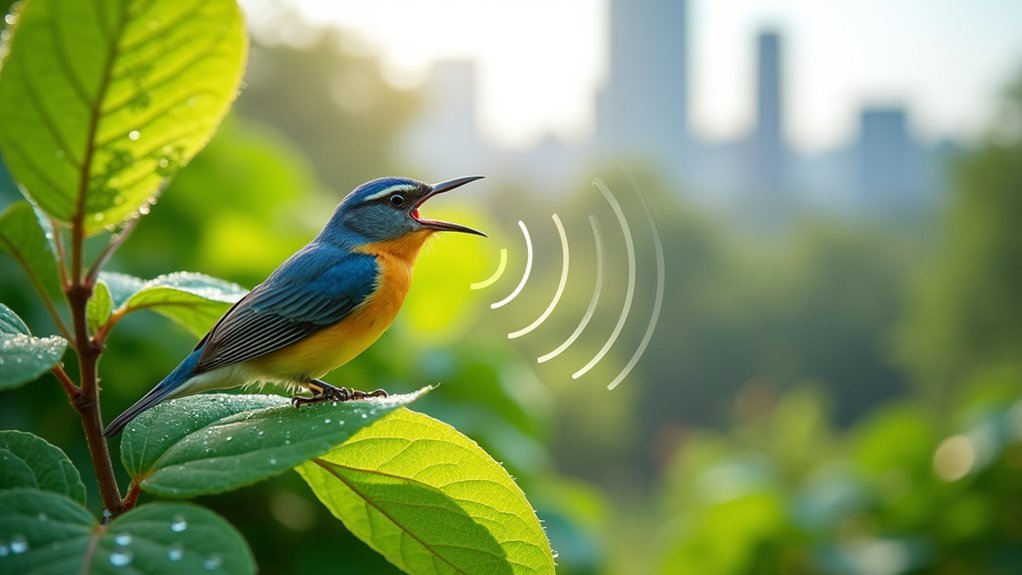You can track invasive bird species at home by setting up feeders and baths as monitoring stations, installing smartphone apps like iNaturalist or EDDMapS, documenting sightings with photos, creating a neighborhood reporting network, observing seasonal patterns, participating in collaborative mapping projects, and implementing humane deterrents. Keep detailed logs of what you see, when you see it, and any unusual behaviors. The following strategies will transform your backyard into a citizen science hub.
Setting Up Backyard Bird Monitoring Stations

While many homeowners enjoy casual birdwatching, creating a dedicated backyard monitoring station transforms this hobby into valuable scientific data collection. Your station becomes a consistent observation point where you can document the presence of both native species and potentially harmful invasive species.
Start by installing various feeders and a bird bath to attract diverse birds. Position these elements where you can easily observe visitors throughout the day.
Strategic feeder and bath placement creates your observation window to the avian world.
Then maintain a detailed log recording dates, species identified, and any unusual behaviors.
Consider adding birdhouses designed for specific native species to encourage breeding. This not only supports local bird populations but provides insights into how invasive species might be affecting them.
Connect with local birdwatching groups to share your findings and learn which invasive species to watch for.
Identifying Common Invasive Bird Species
You’ll find it easier to spot invasive birds like European Starlings and House Sparrows by focusing on their distinctive features, including the Starling’s iridescent sheen and the Sparrow’s chunky profile with short tail.
Tracking seasonal movement patterns can reveal when these non-native species arrive in your area, helping you document their spread and impact on local bird populations.
Mobile apps like eBird offer simple ways to report your sightings, contributing valuable data that scientists use to monitor invasive species distribution and implement conservation strategies.
Visual Identification Tips
Learning to spot invasive bird species in your neighborhood can greatly aid conservation efforts. When identifying European Starlings and House Sparrows, focus on their distinctive features and behaviors to accurately report sightings.
- European Starling: Look for yellow beaks, iridescent purplish-green plumage that changes with seasons, and listen for their complex vocalizations and mimicry of other birds.
- House Sparrow: Note their stocky build, brown and gray coloration, and preference for urban environments—they’re commonly found near buildings, outdoor cafés, and parks.
- Document your sightings: Take clear photos capturing key features, record location details, and share your observations through citizen science platforms like EDDMapS or iNaturalist to help researchers track population spread.
Migration Pattern Tracking
Beyond identifying invasive birds by appearance, understanding their migration patterns reveals how they spread and colonize new territories. You can participate in tracking European Starlings, House Sparrows, and Rock Pigeons by joining citizen science platforms like eBird. By regularly submitting your sightings, you’ll contribute valuable data that helps researchers monitor these species’ rapid expansion across North America.
Watch for seasonal movements and document when and where you observe these birds establishing nests. Their high reproductive rates and adaptability make tracking essential for conservation efforts.
Consider using iMapInvasives to record sightings with precise location data. Pay attention to behavioral patterns too—noting how these birds interact with native species provides insights into their ecological impact. Your consistent observations can inform effective management strategies to protect local biodiversity from invasive pressure.
App-Based Reporting Tools
How can you easily identify and report invasive bird species in your neighborhood? Smartphone apps like iNaturalist and EDDMapS have transformed citizen science, allowing you to contribute valuable data while learning about local ecosystems.
These powerful tools help you:
- Capture and submit photos of suspected invasive birds, with AI-powered technology suggesting species identifications that experts can verify.
- Access interactive maps showing the distribution and spread of invasive species in your region, helping you understand local impact patterns.
- Join a community of observers whose collective reports build extensive databases that researchers and conservationists use to develop management strategies.
Your contributions through these apps not only track invasive birds but also raise awareness about their effects on native populations, making you an active participant in conservation efforts.
Using Smartphone Apps for Bird Documentation
Anyone with a smartphone can become a citizen scientist in the fight against invasive bird species. Apps like Merlin Bird ID and eBird transform your casual observations into valuable scientific data that helps track the spread of non-native birds.
These apps utilize your location data to document sightings, while features like photo ID and song recognition guarantee accurate species identification. You’ll quickly learn to distinguish between native and invasive birds in your area.
eBird’s real-time visualization tools let you see population trends and report unusual sightings to local ornithologists.
You can also connect with fellow birdwatchers through community features, joining challenges and sharing observations.
Creating a Neighborhood Reporting Network

While individual efforts are valuable, establishing a neighborhood-wide invasive species reporting network dramatically multiplies your impact. Encourage neighbors to use platforms like EDDMapS or iMapInvasives to document sightings in your area, then create a shared online database where residents can upload photos with GPS coordinates.
Organize community workshops with local experts to help everyone accurately identify key invasive species.
Consider these engagement strategies:
- Partner with local environmental organizations for resources and guidance
- Host monthly “identification walks” through different parts of the neighborhood
- Create friendly competitions with small prizes for most species reported or largest removal efforts
These collaborative approaches transform isolated monitoring into a coordinated early warning system that can quickly identify and address new invasions.
Seasonal Patterns of Invasive Bird Activity
You’ll notice invasive birds appear and disappear throughout the year as migration patterns influence when these species can be detected in your area.
During breeding season, invasive birds like European starlings and house sparrows become particularly visible as they aggressively compete with native species for nesting sites and food resources.
Migration Affects Detection
As seasons change throughout the year, so do the detection patterns of invasive bird species in your local area. Migratory movements greatly impact when and where you’ll spot these non-native birds, making timing essential for effective monitoring.
When tracking invasive birds, remember these key points:
- Schedule your observation efforts during seasonal change periods when migratory invasive species typically arrive in your region.
- Look for resource competition between native and invasive birds, especially during peak migration when resources may be limited.
- Report your sightings to citizen science platforms like EDDMapS or iMapInvasives, specifying whether the species appears to be resident or migratory.
Understanding these migration patterns helps predict future spread and allows for more targeted management interventions when invasive populations are most vulnerable.
Breeding Season Hotspots
Beyond migratory patterns, the breeding season creates distinct hotspots of invasive bird activity that you can monitor from your own backyard. Spring and early summer offer prime opportunities to observe European Starlings and House Sparrows as they establish territories in urban settings.
| Species | Behavior Cues | Best Time to Monitor |
|---|---|---|
| European Starling | Metallic calls, nesting in cavities | Dawn, March-May |
| House Sparrow | Chirping groups, nest building | Midday, April-June |
| Monk Parakeet | Loud squawking, communal nests | Afternoon, February-July |
You’ll gather valuable data by documenting distinctive vocalizations and nesting behaviors. Share your observations through citizen science platforms like eBird or iNaturalist to help researchers track population spread. These seasonal patterns provide essential insights for developing targeted management strategies that protect native bird species.
Collaborative Mapping With EDDMAPS

While many invasive species continue to spread unchecked across the country, EDDMapS offers a powerful solution through its collaborative mapping platform.
You’ll contribute to a nationwide database that helps track invasive species distribution while gaining insights about infestations in your area.
The platform transforms citizen science into actionable data through:
- User-friendly reporting tools that make submitting sightings quick and accurate
- Interactive maps that visualize species spread and regional hotspots
- Statistical analysis that helps you understand invasive trends in your community
Your observations, governed by a Code of Conduct ensuring ethical and accurate reporting, connect with agricultural partners and local organizations.
This collaborative network strengthens early detection efforts and improves management strategies against invasive threats in your neighborhood.
Implementing Humane Deterrent Strategies
Managing invasive species doesn’t require harmful chemicals or cruel elimination methods. You can effectively use natural repellents like vinegar or essential oils that deter unwanted species while protecting native wildlife and ecosystems.
Gentle management of invasive species protects biodiversity while respecting all living creatures in our shared environment.
Consider installing physical barriers such as fencing or netting around vulnerable areas to prevent invasive animals from accessing your garden.
Encouraging native predators creates a natural balance that helps control invasive populations.
Make your property less appealing to invasives by modifying habitats—remove potential food sources and eliminate shelter opportunities.
Regular monitoring of your yard allows you to spot early signs of invasive species and implement deterrents before populations become established.
These humane approaches not only protect your property but also contribute to broader conservation efforts while maintaining ecological harmony in your community.
Frequently Asked Questions
What Is the 10 10 10 Rule for Invasive Species?
The 10 10 10 rule identifies threatening invasive species that can spread 10 miles in 10 years, reproduce 10,000 seeds per individual. You’ll find it’s used to prioritize management efforts for concerning invasives.
Is There an App to Identify Invasive Species?
Yes, you’ll find several apps for identifying invasive species. iNaturalist and Seek offer photo identification with AI assistance, while EDDMapS and iMapInvasives help you track and report sightings in your area.
What Is the #1 Most Invasive Species?
The #1 most invasive species in the U.S. is the common reed (Phragmites australis). You’ll recognize it by its towering height of up to 15 feet and dense growth that quickly overtakes wetland ecosystems.
What Is the Invasive Species Monitoring Protocol?
The Invasive Species Monitoring Protocol is a standardized framework you’ll follow to identify, document, and report invasive species. It guarantees you’re collecting accurate data while using proper identification techniques and reporting platforms like EDDMapS.
In Summary
By tracking invasive birds in your backyard, you’re making a valuable contribution to environmental conservation. You don’t need to be a scientist to help—just your smartphone, some basic knowledge, and community connections. Start small with one monitoring method, then expand as you gain confidence. Remember, your observations aren’t just data points; they’re essential steps toward protecting your local ecosystem’s biodiversity for future generations.





Leave a Reply